Building 21’s Studio Model: Designing Learning Experiences for Engagement and Impact
CompetencyWorks Blog
Links to other posts in this series by Sandra Moumoutjis are at the end of this article.
As we continue our journey to personalized and competency-based education, we need to rethink the design of our teaching and learning experiences. In my blog that focused on Building 21’s Teacher Competencies to Facilitate Competency-Based Learning, I outlined some of the shifts in mindsets and practices that need to occur with the adults to transform our learning environments from being teacher-centered to student-centered. In a CBE model, teachers become facilitators of student learning, meeting students where they are and providing instruction, guidance, and feedback to support students in their progression along the competency learning continuum. Students are given more choice and voice in how and where they demonstrate their learning and, with the teacher, become co-designers of their learning pathway.
Competency-based education requires demonstrations of learning. These demonstrations should be rigorous and engaging performance-based assessments that are aligned to competencies and require students to apply their learning in a meaningful way. Focusing on the skills of the competency allows students to work on mastering academic and nonacademic skills that are essential to their post-secondary success. The chart below shows how performance-based assessments are both higher in rigor along the Bloom’s Taxonomy continuum and higher in complexity along the Webb’s Depth of Knowledge continuum:
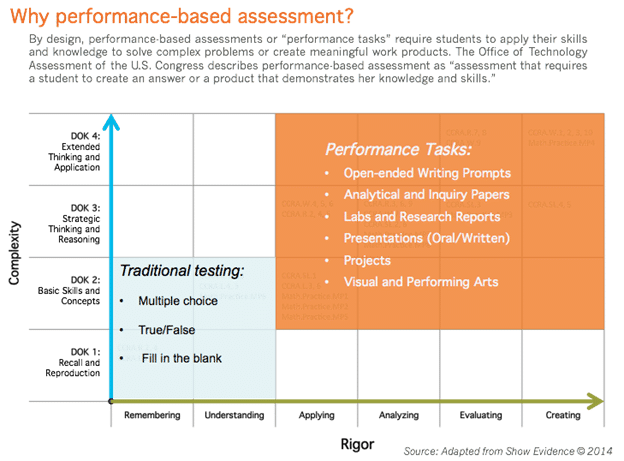
We developed the chart below to outline some of the key instructional shifts that need to occur when we work with schools to transition from a traditional education model to a CBE model:

For us, at the heart of these instructional shifts is making learning expectations consistent and transparent for all students across all learning experiences through our Building 21 Competency Framework and making learning more engaging and relevant to students through inquiry-based, project-based, and/or problem-based learning. These instructional shifts are also very much about equity. Oftentimes, we think of project-based or problem-based learning as either a reward for doing well or as a fun break from the normal curriculum. Sometimes we withhold these real-world learning experiences from students because we do not think they are ready and we focus on lower-level skill instruction instead. Especially now, during this pandemic, we are seeing students with more unfinished learning. But instead of engaging them in higher-level thinking and meaningful activities, we are remediating through traditional skill instruction. This approach is only creating a bigger gap in learning, and disproportionately for children of color.
In the article Zaretta Hammond on Equity and Student Engagement, Ms. Hammond warns against compliance-based education:
I think one of the biggest mistakes we make, particularly for struggling students, who are disproportionately children of color, is that we employ a pedagogy of compliance. I mean, if you look at what’s being put in front of these students sometimes, it’s kind of mind-numbing. There’s no complexity to the work. It lacks any real-life context to address the typical student question of “What’s the use of me learning this?” The learning is too decontextualized and compartmentalized.
Later in the article, Ms. Hammond explains why she is very concerned that the focus on “learning loss” during the pandemic might make schools double down on compliance-driven education:
…we talk about equity, but we go back to a pedagogy of compliance, especially for BIPOC students who may be behind. We see it in talk about high-dose tutoring and more pull-out programs focused on remediation. Schools say they don’t have time for project-based learning, or maker spaces, or any of that because they have so much ground to make up. But we make up ground by actually using intellectual curiosity to turbocharge students’ engagement. We need to water up the curriculum and instruction, not water it down.
At Building 21, our instructional model is designed around the belief that all students should experience engaging and relevant problem-based/project-based learning and that unfinished learning can be addressed through personalized support, instruction, and feedback. We design our learning experiences to differentiate instruction, meeting students where they are on the continua and giving students multiple opportunities to show progress and growth in their competency portfolios.
To realize the potential of competency-based learning, we must fundamentally shift how we design learning experiences to ensure that they:
- Are student-centered
- Culminate in a performance-based assessment that calls on students to apply knowledge and skills
- Provide opportunities for feedback and revision
- Are rated against a transparent continuum or scale providing individualized information on learning, growth, and progress
- Provide opportunities for students to make a real-world impact
Studio Design at Building 21
We have worked hard over the last eight years to codify a process that promotes the key design features outlined above. Our central unit of design is called a “studio.” A studio is a learning experience that is designed around a set of competencies using the Building 21 Competency Framework. Every studio starts with a problem frame and ends with a culminating performance-based assessment and an implementation. Studios vary in length, usually lasting between 6-12 weeks.
Studios consist of milestones and stepping stones that are independent but interrelated experiences that lead up to the culminating performance-based assessment. We believe the learning becomes even more meaningful if students are examining real world problems and relevant content with the opportunity to implement their learning for an authentic purpose or audience.
Studio Cycle
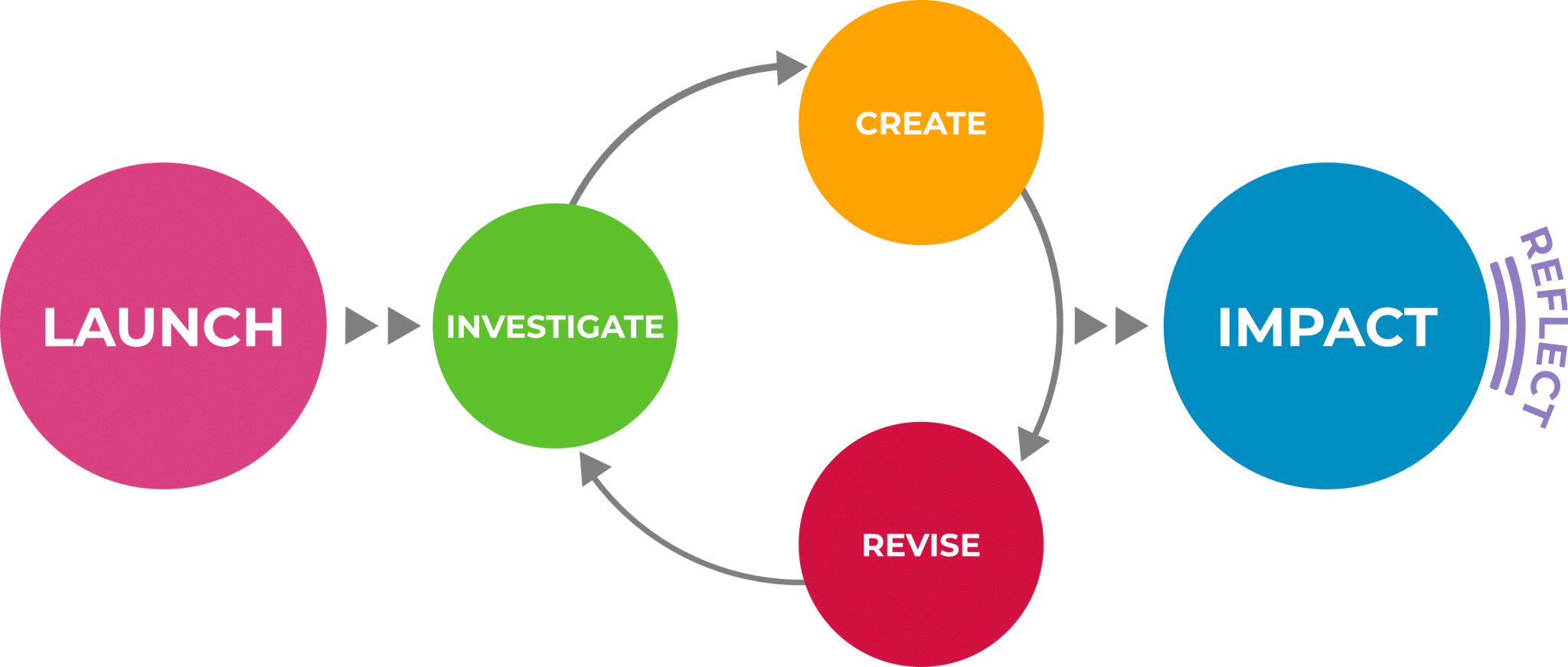
Stages of the Studio Cycle
LAUNCH
During the Launch, the goal is to hook students by engaging them in the problem frame. Your studio should always start by providing the “why” for students—“Why are we learning this?” and “Why is this relevant to me?” Activities designed for the launch should create a shared understanding of the problem by accessing students’ prior knowledge and building their necessary background knowledge, vocabulary, and the context they will need to engage in the studio. Students should leave the Launch knowing which competencies they will be learning and what the culminating performance task is.
INVESTIGATE
During the Investigate stage, the goal is to engage students in developing a deep understanding of the problem and related content while building the skills necessary to complete the Culminating Performance Assessment. In this section, you will plan each Milestone by developing the individual Stepping Stones necessary to build both content knowledge and skills. You can also embed experiences that help students connect the studio to relevant career exposure in the career field or career cluster you identify for your studio.
CREATE
Throughout the Create stage, you will give students the opportunity to demonstrate their learning through performance-based assessments. After a skill or series of skills is learned, students will complete a performance task that demonstrates both their mastery of competencies and their understanding of the essential content. A studio may have multiple performance tasks leading up to the culminating performance task. Students should be given meaningful choice in how they demonstrate their learning.
REVISE
The Revise stage happens throughout the Create stage. It is essential in a competency model to provide students with multiple opportunities for feedback and revision to show progress and growth. Opportunities should include continua-based self-assessment, peer feedback, and teacher feedback. You should plan for at least one revision cycle for each performance task.
IMPACT
In the Impact stage, students apply their learning in an authentic way. Students are able to connect what they learned to solve a real-world problem. Some examples of how students can apply their learning to make an impact are by implementing their action plan, publishing their editorial or narrative, displaying their artwork, presenting at a board meeting or town hall, building their design, creating their product, holding a performance—any authentic demonstration of their learning for a broader audience.
REFLECT
The Reflect stage happens at the end of every studio, and time should be set aside for students to engage in a reflection process. This process will help students reflect on their learning, new understandings, or perspectives they have gained; their intended impact and whether or not it was achieved; and their personal growth and competency/skill growth. They can also reflect on the studio and give feedback to the teacher about what went well and what could be changed or revised to better meet the needs of each learner.
The Studio Design Process
The studio design process begins with the Studio Map. Using the map, teachers or other designers brainstorm ideas for their studio in a 45-60-minute workshop session. Then, designers get feedback from their peers on their studio ideas before they begin the full design process.

After receiving feedback on the Studio Map, designers begin to work through the Studio Design Template. The template guides teachers through each stage of the studio. Our studio design process follows the backwards design process and is informed by Grant Wiggins and Jay McTighe’s Understanding by Design (UbD).
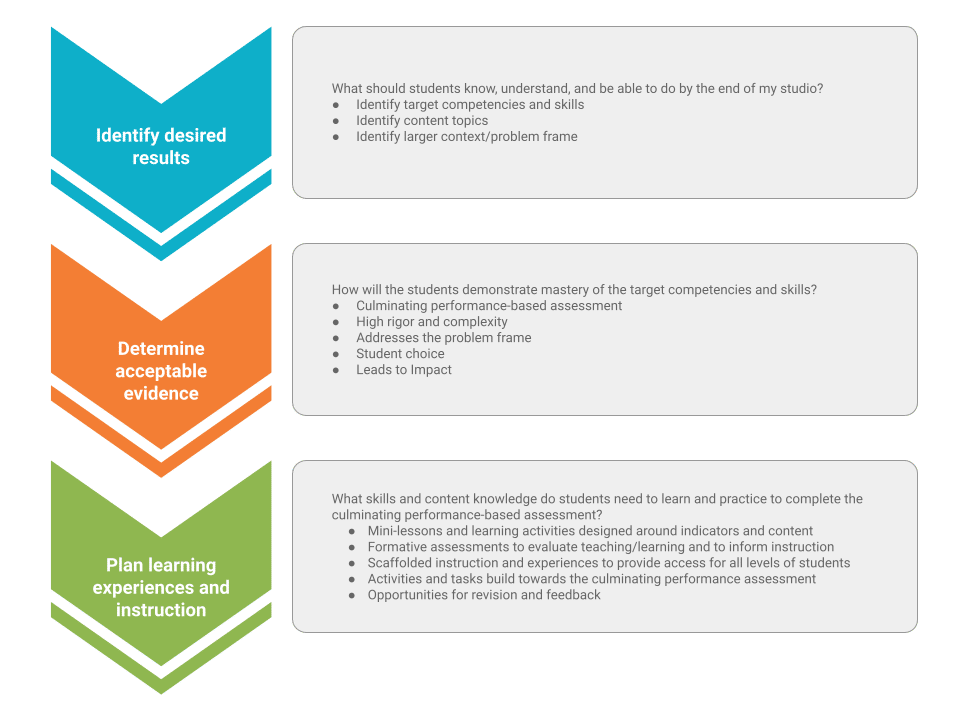
It is important to build in checkpoints throughout the design process to give designers feedback on each stage of the studio design. This Studio Design Feedback Checklist can be used throughout the feedback process.
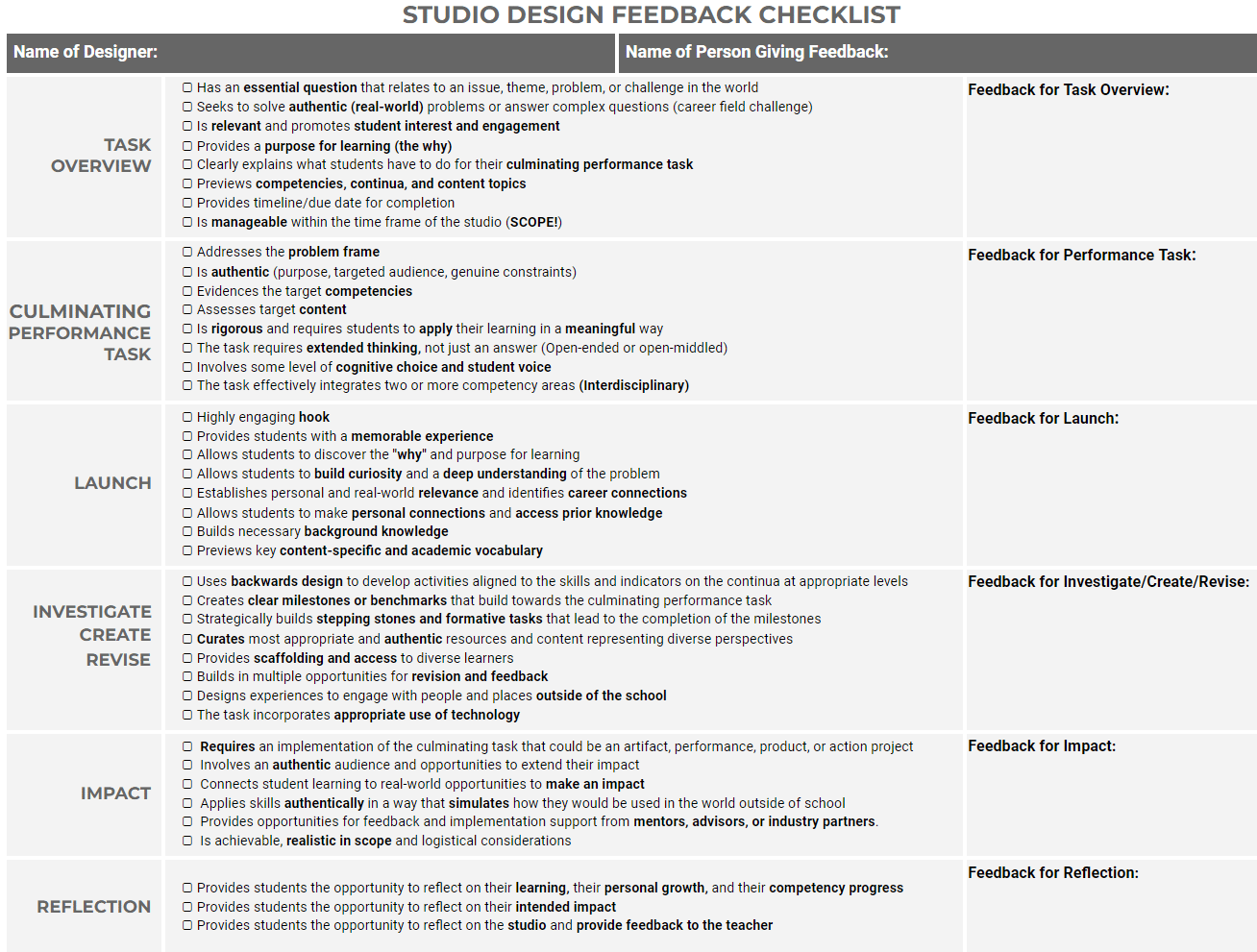
One of the key areas for feedback is to provide designers with actionable ideas on how to move their studio to higher levels on the continuum of rigor and authenticity. This graphic from NGLC’s MyWays Student Success Series: What Learners Need to Thrive in a World of Change helps designers understand the relationship between the two:
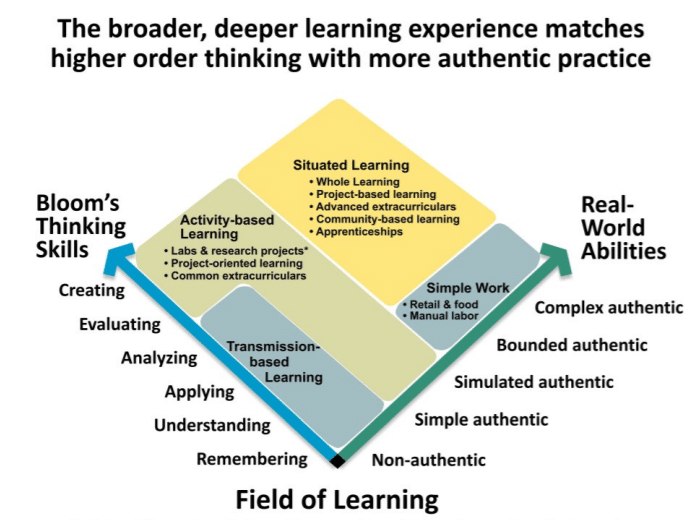
Teacher Competency: Designing for Engagement and Impact
In order to support our teachers in becoming studio designers, we have created a Teacher Competency that allows teachers to grow into designers by following the design progression.

Making the instructional shift to the studio model requires time and a commitment to developing teachers as designers. Building 21 has supported the studio design process with our lab schools and with other schools in our Learning Innovation Network in a variety of ways. For a week in the summer, we run a design institute where teachers from schools across our network come together for professional development and collaborative studio design sessions. With our schools that have been able to fund studio design outside of the school day, we have run virtual studio design sessions with teachers to support collaboration and feedback. In both our lab schools, we adjusted our students’ instructional minutes and can dismiss them two hours early, one day per week. We then devote these two hours to professional learning for our adults, which includes instructional design. Our schools also build additional collaborative planning time for all teachers into their master schedules.
Which brings me to the topic of my next blog post. Many of the shifts to CBE require us to rethink the traditional structures of school and how we are using our resources. Check back soon to read more about breaking down the traditional barriers of time-based, age-based, grade-based, and course-based structures.
Learn More (other posts in this series)
- Why Should Schools Transition to Competency-Based Education?
- Preparing for Your Competency-Based Education Journey: A Process for Success
- Building 21’s Teacher Competencies to Facilitate Competency-Based Learning
- Building 21’s Leadership Competencies to Facilitate Competency-Based Learning
- Replacing the Grammar of Schooling with Competency-Based Innovations
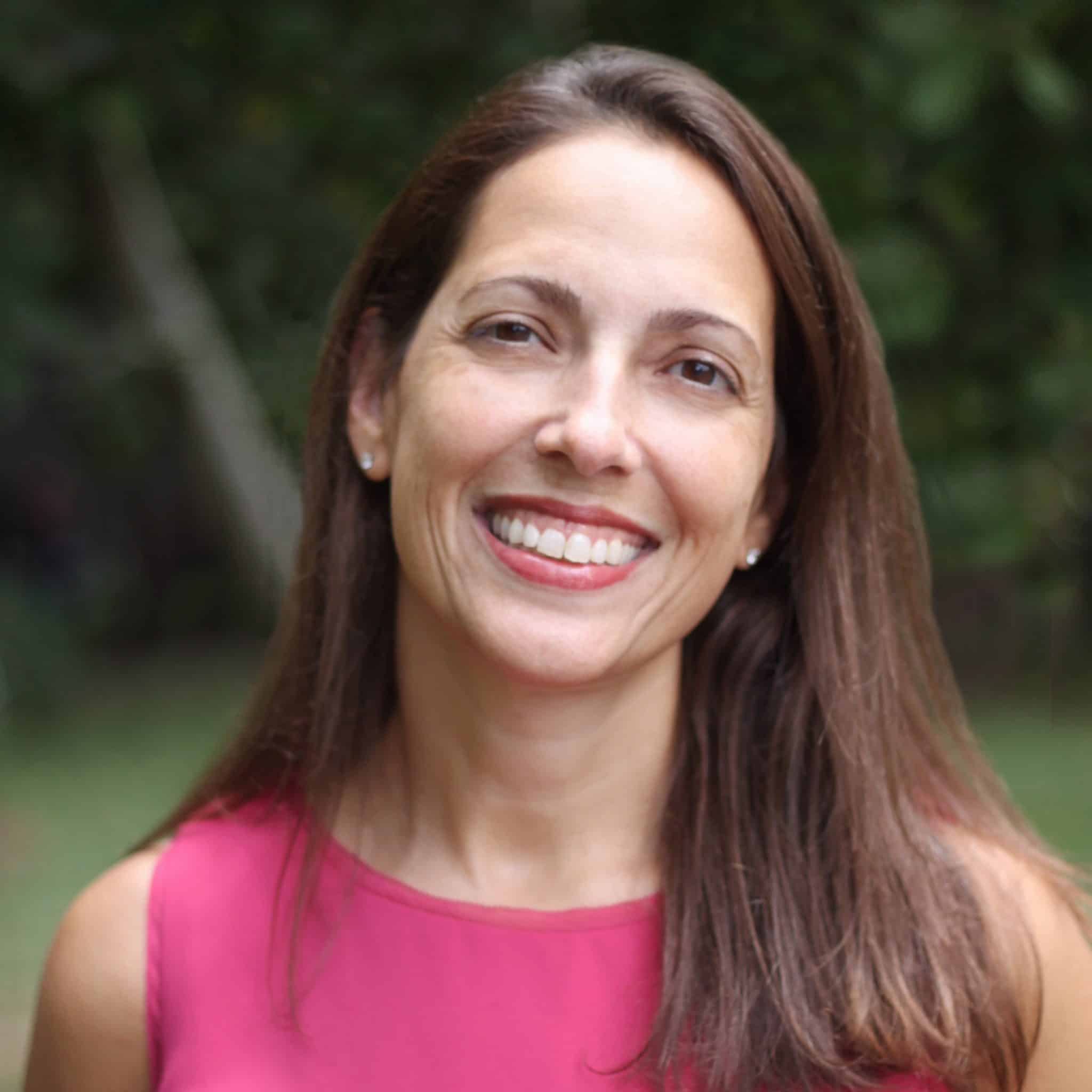 Sandra Moumoutjis is the Executive Director of Building 21’s Learning Innovation Network which is designed to grow and support a community of schools and districts as they transition to competency-based education. Through professional development and coaching, Sandra supports schools and districts in all aspects of the change management process. Sandra is the co-designer of Building 21’s Competency Framework and instructional model. Prior to working for Building 21, Sandra was a teacher, K-12 reading specialist, literacy coach, and educational consultant in districts across the country.
Sandra Moumoutjis is the Executive Director of Building 21’s Learning Innovation Network which is designed to grow and support a community of schools and districts as they transition to competency-based education. Through professional development and coaching, Sandra supports schools and districts in all aspects of the change management process. Sandra is the co-designer of Building 21’s Competency Framework and instructional model. Prior to working for Building 21, Sandra was a teacher, K-12 reading specialist, literacy coach, and educational consultant in districts across the country.